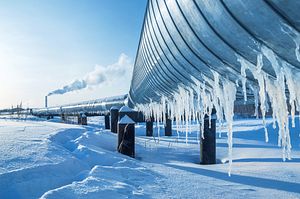While the EU has been historically dependent on Russian oil and gas supplies, this dependence has proved to be a two-way street, with Russia dependent on European goods and technology. This trade has nonetheless remained asymmetrical: Russia imports equipment, consumer goods, and high value-added products (such as luxury garments, cars, and foods), while it exports raw materials. Today Russia’s hydrocarbons are becoming harder to find and more expensive to produce even though the country’s technologically underdeveloped economy relies increasingly on the revenues they ensure. Moreover, despite possessing over 30 percent of global gas supplies and unconventional gas reserves that are estimated to be ten times larger than those in all of Europe, today’s Russia is heavily reliant on Western technology to boost energy extraction and develop these promising resources.
Russia’s economy dependence on hydrocarbons is a bad story that is destined to get worse. For years Vladimir Putin has been reminding Russians that urgent action is needed to modernize and diversify Russia’s economy, develop domestic expertise, and foster energy market reforms. But given that his own system rests on the informal glue of corruption, Russia has – unsurprisingly – largely failed to address the state’s meddling in business, shortcomings in the rule of law, and takeover of the energy business by politically favored interests. Consequently, energy reform never became a viable option. Instead, Russia has been trapped in a vicious circle whereby its capacity to hire foreign specialists and purchase required energy technologies depends heavily on revenues from oil and gas exports, and thus, on oil and gas prices. This unsustainable situation was in place even before the two disastrous – from Russia’s perspective – recent developments: sanctions and the decline in the price of oil. Today, with the Urals crude around $50 a barrel, Russia’s ability to harness Western technology is greatly undermined. Moreover, because of sanctions, Russia faces severe limits on its residual ability to acquire the technologies that the country needs to develop the promising but nonetheless geologically challenging offshore and onshore sites in the Arctic and Eastern Siberia.
ExxonMobil’s pulling the plug, despite initial exploration success, on its $3.2 billion investment for drilling in Russia’s Arctic Sea in partnership with Rosneft, and the likely cancellation of Gazprom’s $65 billion Vladivostok LNG, are both clear cases in point.
In the past, Russia sought strategic modernization alliances with Europe and the U.S., rather than with China, to help mitigate its technological decline. Especially during Medvedev’s presidency, Russia’s “technology drive” was articulated in the launching of Skolkovo, a project conceived with the hope of emulating Silicon Valley. But instead of making a strong case for systemic reform, Medvedev endorsed a skewed notion of top-down modernization, which failed to create the incentives needed to attract capital, technology and skills, thereby failing to loosen the country’s dependency on movements in international commodity prices. In 2012, with Putin’s return to the presidential seat, Russia’s obsession with Western technology was gradually substituted by a fascination with China’s economic and technological development. At the end of January 2012, just before the presidential elections, then Prime Minister Putin set out his vision for Russia’s economic development in a lengthy article in the Russian business daily Vedomosti. What became obvious was that Putin was acutely aware of Russia’s technological gap and the need to rebuild Russia’s technological base. But in the same article Putin also wrote: “The successful economic modernization experience of such countries as Korea and China shows that a push in the right direction from the government is necessary.” In fact, while in 2012 Russia was still willing to welcome Western expertise and capital, institutionally, Putin was increasingly leaning towards Chinese-style state capitalism.
Unlike in 2012, today’s mixed effect of sanctions and the collapsing price of oil portends a protracted ban on Western technology for Russia. The country is stuck. It needs to continue producing hydrocarbons in order to keep its economy afloat, but its ability to do so is intimately tied to the availability of Western lending and the leading edge of Western energy industry. China, which has been loath to condemn Russia over Ukraine, is currently viewed by the Kremlin not only as an institutional role model, but also as a potential panacea to Russia’s problems.
But can China solve Russia’s technology trap? In one word, the answer is no. To be sure, a lot of technological advances depend on financing capability and China surely has deep pockets. But China simply doesn’t yet possess the advanced technology that Russia needs in order to develop its hard-to-reach, geologically hazardous areas in the Arctic and Eastern Siberia. Chinese energy companies can, however, assist Russian counterparts with developing less technologically complex projects under better geological and climatic conditions, such as those in Western Siberia. In this situation, Russia’s nightmare may be unfolding. The country now truly risks becoming China’s resource appendage, and even worse, if the price of oil doesn’t recover any time soon, there is a very real risk of chaos, fragmentation, and collapse. Under these circumstances, the very viability of the current Russian state may be at stake.
Morena Skalamera is a postdoctoral fellow conducting research on the geopolitics of energy at Harvard’s Kennedy School.

































